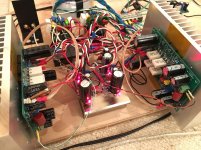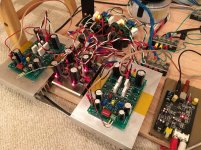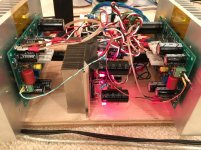What supply voltage are you using ? 30-0-30 V transformer ?
So you would have now tested the sound in stereo mode. How does it compare with other power amps you have built ?
Currently 36v rails for initial testing. Need 50v elco caps before test at 50v.
Just 5 songs so far - sounds great. 140mA bias ea makes heat.
Cool! 🙂 Does this one go into a box?
Maybe. Need more listening and test at 50v. So far so good though. That square wave is exceptionally clean.
Solidly mounted to heatsink now. Offset is stable to 5mV after warmed up. Bias is stable and set currently at 150mA. Heatsink is not too warm at all. Sounds really nice. Super easy to make and parts are not expensive at all. Great amp. Nice deep bass, smooth mids and clear highs.
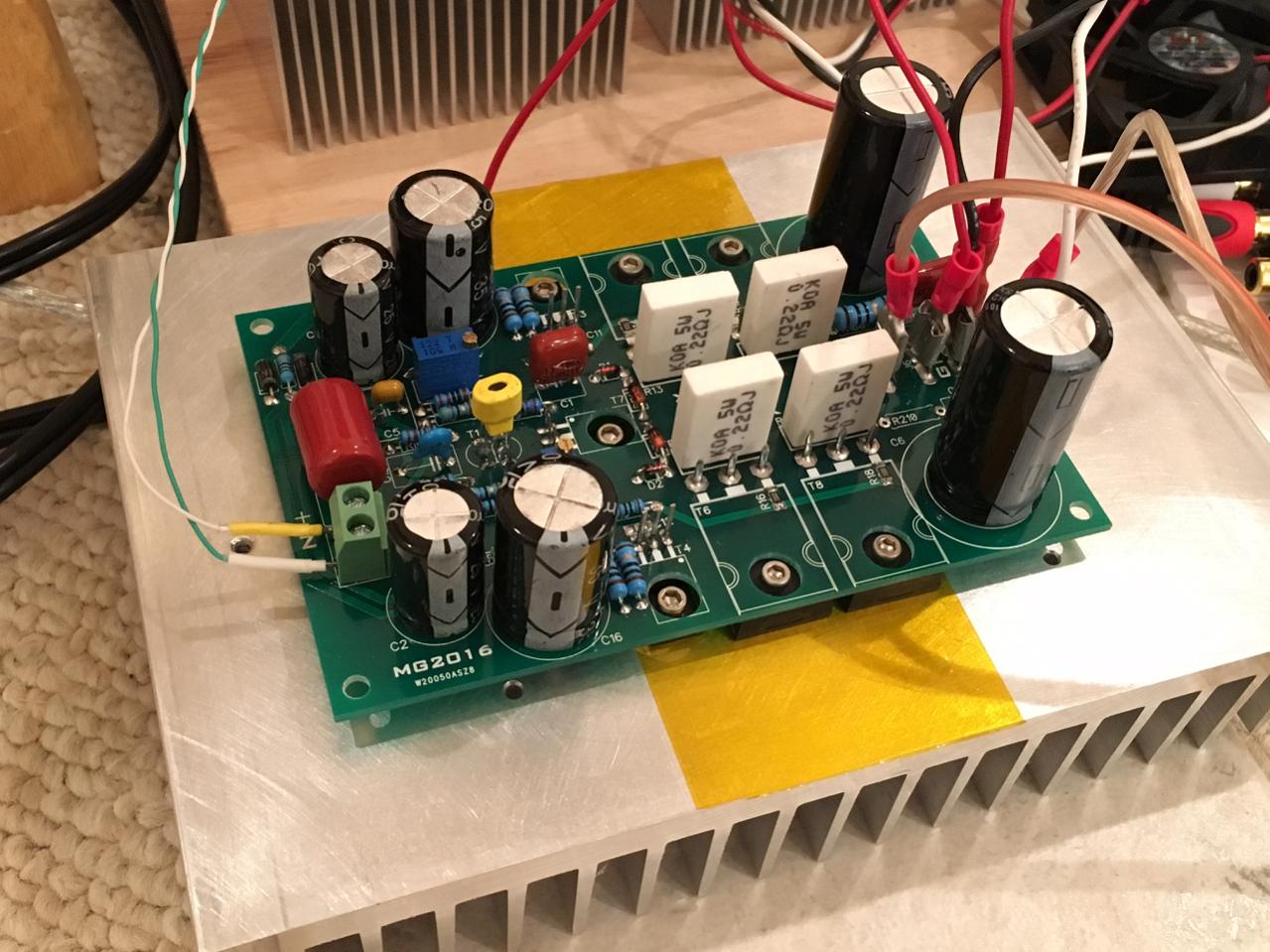
Note that bias current is monitored via output and Source pin sticking up from one of the MOSFETs. Be careful not to short the pins with the alligator clip.
Looking good XRK !
Seem like you used some low inductance resistors in the OPS.
I happen to have those - did not know they were low inductance units. I normally use 2w or 3w metal thin film ones here but Marc had it drawn for small stand up rectangular resistors.
are they low inductance?Yes X,
MPC71 are low inductance resistors, and they have a frendly parttern and price i find. You can find then under fukushima brand...
Marc
What does the datasheet have to say on inductance?
Does the "J" mean 5% tolerance?
The Zobel half of the Thiele Network only operates at frequencies well above Audio range. This demands that the Zobel must have low inductance routes back to where the the HF currents came from. This means the route from output device to Zobel and back to the local decoupling MUST be kept very short and close coupled trace pairs. This means on the PCB.I think AndrewT suggested outboard mounting even at the speaker terminals. 1.0 to 1.2uH and 10R 2W in parallel. ...................
The inductor half only has to pass audio frequencies. These do not need low inductance in the traces. The inductor has effects on other components and is itself affected by other components and materials. This then requires that the inductor is not located on the PCB. It is better to locate the inductor in the wire pair that feeds the output terminals.
+1 @AndrewT
I will only add that the parasitic nature of traces and their field effects are too often overlooked.
I will only add that the parasitic nature of traces and their field effects are too often overlooked.
I have spent about 5 hrs listening (in stereo of course) to this CFH9 amp with a variety of genres - it still sounds great and is very good. I am looking forward to trying it with 50v rails to see if I can hear a difference. The DC offset remains stable within 3mV still.
Hello Sonal
greetings is it possible for you to post sprint lay files of 2 pair CFH7 amp
warm regards
Andrew
greetings is it possible for you to post sprint lay files of 2 pair CFH7 amp
warm regards
Andrew
I can't see any specification for inductance.
They do print in the headline features: "low inductance".
I wonder what they mean.
Hello Sonal
greetings is it possible for you to post sprint lay files of 2 pair CFH7 amp
warm regards
Andrew
Sprint lay file for CFH9.
Attachments
300VA trafo and 39v rails with cap multiplier
I finished my Juma Easy Peasy cap multiplier for stereo and am using it with a 300VA 28VAC trafo which makes 44VDC upstream of the cap multiplier. The cap multiplier loses 5v but ripple as measured with DMM in power supply is now very low, somewhere around less than 1mV. I am running 460mA total bias current (measured with clamp current meter). It feels pretty toasty - almost class A like. I guess it is dissipating about 36w at idle.
Here is the cap multiplier:
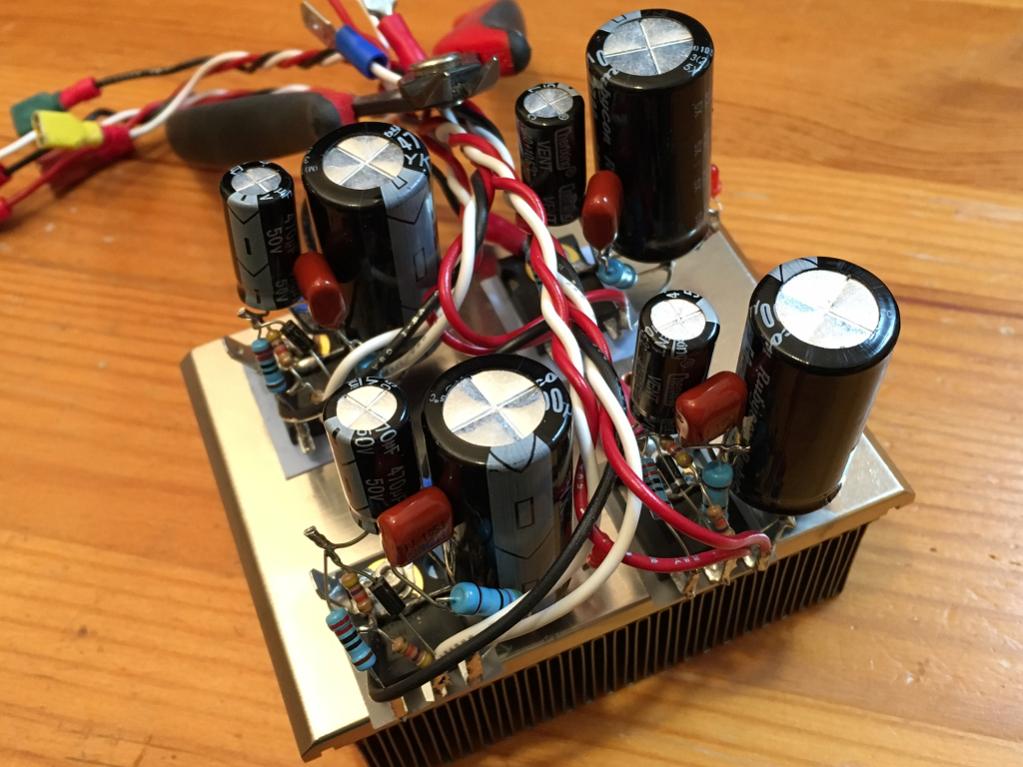
So, what does it sound like? Very very nice. Great powerful bass transients, deep reach. Excellent smooth mids and sparkling and clear highs. No issues. The extra voltage really made the amp come alive. I really like it - it is probably one of my top 3 amps now.
Listening to high rez FLAC of Dave Brubeck at 176k through XMOS U8 and BB PCM5102A DAC with external shunt reg PSU. Very very nice.
Here is the amp with cap multiplier and bigger 300VA trafo.
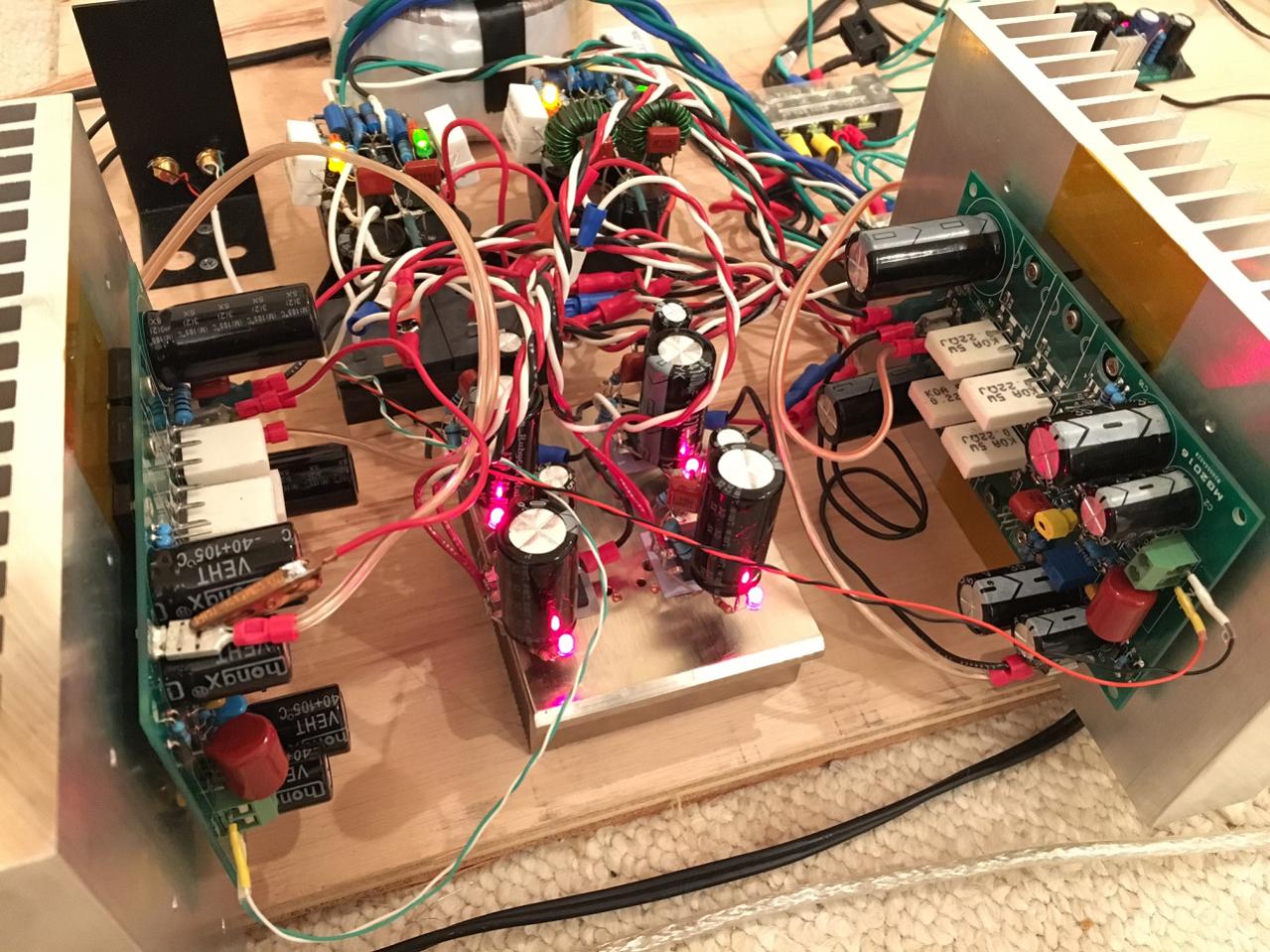
I finished my Juma Easy Peasy cap multiplier for stereo and am using it with a 300VA 28VAC trafo which makes 44VDC upstream of the cap multiplier. The cap multiplier loses 5v but ripple as measured with DMM in power supply is now very low, somewhere around less than 1mV. I am running 460mA total bias current (measured with clamp current meter). It feels pretty toasty - almost class A like. I guess it is dissipating about 36w at idle.
Here is the cap multiplier:

So, what does it sound like? Very very nice. Great powerful bass transients, deep reach. Excellent smooth mids and sparkling and clear highs. No issues. The extra voltage really made the amp come alive. I really like it - it is probably one of my top 3 amps now.
Listening to high rez FLAC of Dave Brubeck at 176k through XMOS U8 and BB PCM5102A DAC with external shunt reg PSU. Very very nice.
Here is the amp with cap multiplier and bigger 300VA trafo.

Attachments
Last edited:
I am guessing it's about 40C to 50C (touch hand for 12 to 20 Sec) when running 460mA bias. Size of heatsink is ideal I think. It's 5in tall x 7.28in wide. Here is model.
7.280" Wide Extruded Aluminum Heatsink - HeatsinkUSA
I am using 5.0 inch long extrusion.
You could run at lower bias and less heat this is high I think. Semi class A?
7.280" Wide Extruded Aluminum Heatsink - HeatsinkUSA
I am using 5.0 inch long extrusion.
You could run at lower bias and less heat this is high I think. Semi class A?
Last edited:
Sonal PM
Sonal,
I sent you a PM about your CHF9 gerbers. As you are usually quick to respond, you may have sent the reply to yahoo.com rather than yahoo.ca. This happens quite frequently.
Thanks for the help,
Myles
Sonal,
I sent you a PM about your CHF9 gerbers. As you are usually quick to respond, you may have sent the reply to yahoo.com rather than yahoo.ca. This happens quite frequently.
Thanks for the help,
Myles
I forgot to say you can listen to this amp over in the virtual audition thread.
http://www.diyaudio.com/forums/soli...y-simple-quasi-mosfet-amp-30.html#post4885319
http://www.diyaudio.com/forums/soli...y-simple-quasi-mosfet-amp-30.html#post4885319
Update on CFH9
This amp as currently configured is really excellent. I measured the DC offset after warming up today and it is 0mV to 1mV. Bias current is still about the same and stable at 465mA. Here is a photo of the amps flat for visibility and then up in vertical config how they would be mounted if inside a cabinet. The cap multiplier also gets warm but not hot so I rotated it for air flow.
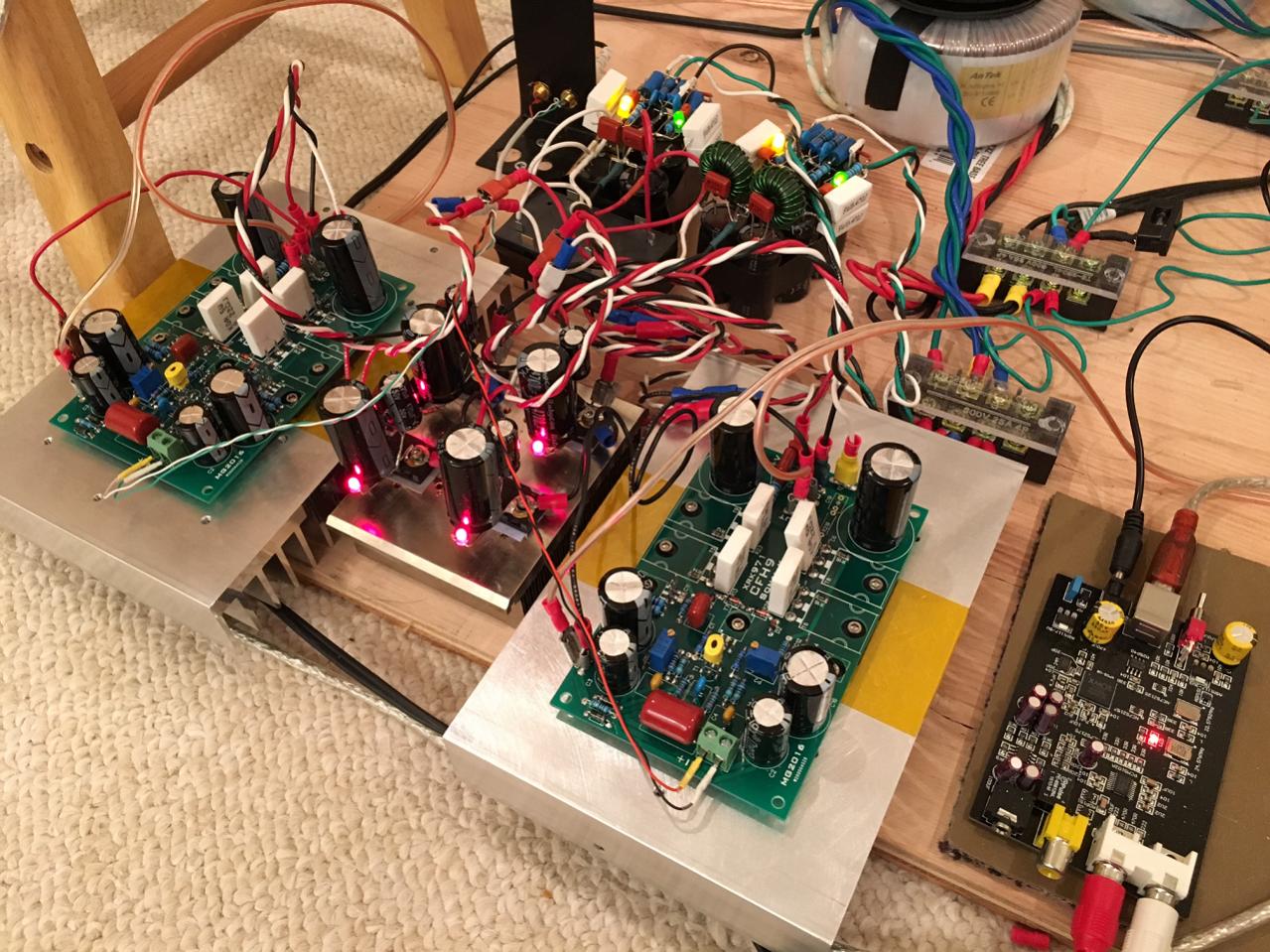
I was listening to a track by Gretchen Parlato that I am very familiar with and heard new details today: the breath she takes in between phrases is now audible whereas before it was not as clear. Nice amp. 🙂
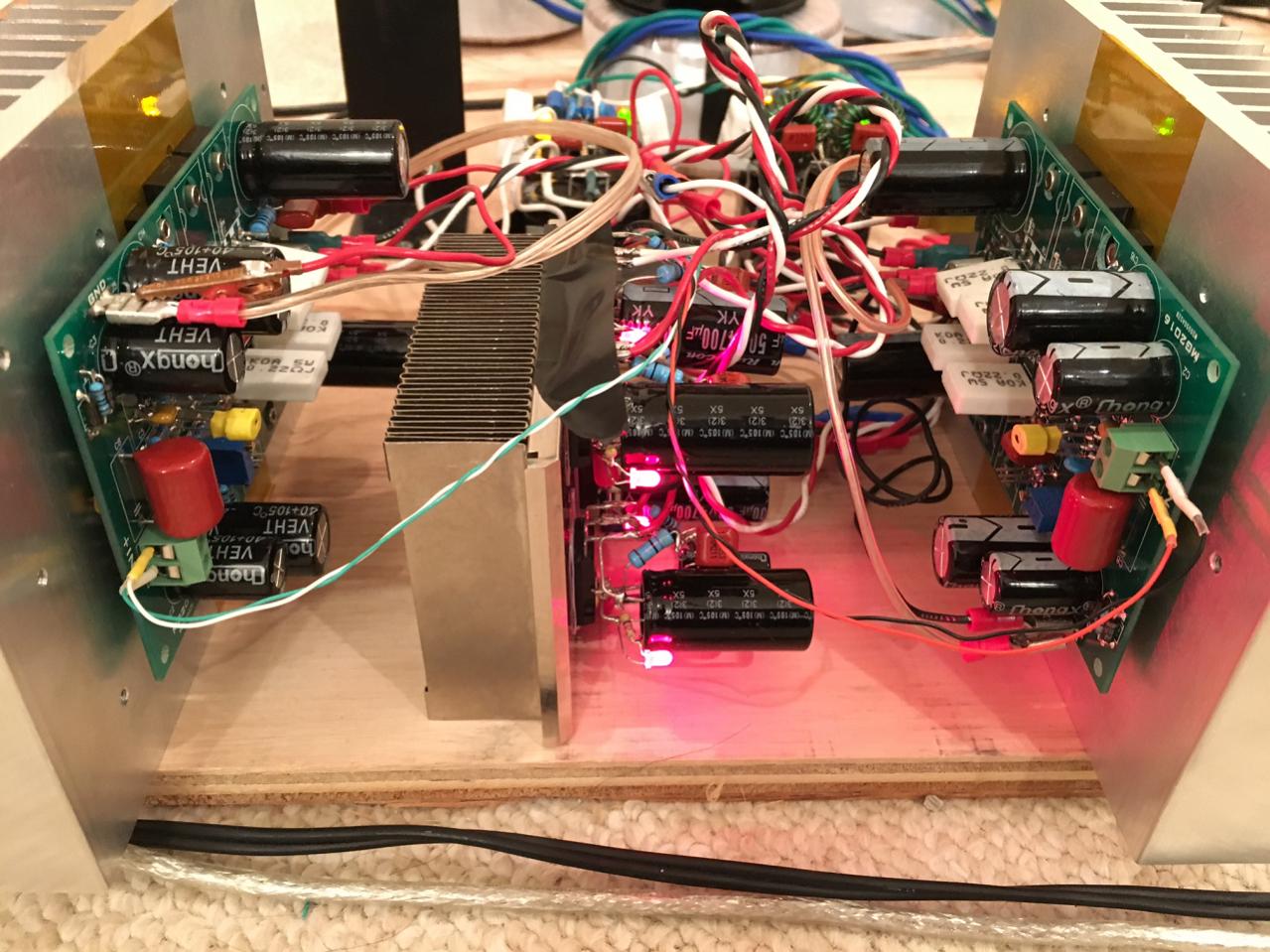
This amp as currently configured is really excellent. I measured the DC offset after warming up today and it is 0mV to 1mV. Bias current is still about the same and stable at 465mA. Here is a photo of the amps flat for visibility and then up in vertical config how they would be mounted if inside a cabinet. The cap multiplier also gets warm but not hot so I rotated it for air flow.

I was listening to a track by Gretchen Parlato that I am very familiar with and heard new details today: the breath she takes in between phrases is now audible whereas before it was not as clear. Nice amp. 🙂

Attachments
- Home
- Amplifiers
- Solid State
- CFH7 Amp

